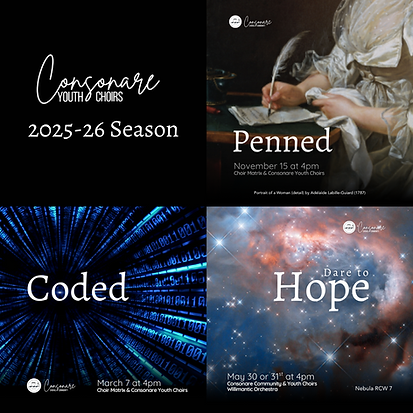RESOURCE PAGE FOR YOUTH CHOIR

Tuition for Session II Winter 2026 is $35.
How to pay tuition:
--bring a check or cash to the first rehearsal
--mail a check to Consonare Choral Community, P.O. Box 338, Mansfield Center, CT 06250
--pay online via in the new registration system (above)
If paying tuition is a hardship for you, please send Sarah an email. If you would like to add a donation to your tuition, you can do so easily and your donation is tax deductible.
WINTER REHEARSALS--SUNDAYS 3:00-4:30pm
Storrs Congregational Church
January 11
January 18
January 25
February 1
February 8
February 15
February 22
March 1
Dress Rehearsal:
Friday, March 6, 2026 at 6:00-8:00pm
Session Concert:
Saturday, March 7, 2026 at 4:00pm
CONCERT ATTIRE:
All black with an optional splash of blue (scarf, hair accessory, jewelry, etc.)
INCLEMENT WEATHER:
Please check your email one hour prior to rehearsal as any rehearsal cancellations will be advised by 2pm the day of rehearsal. If rehearsal has to be cancelled, we will replace the missed rehearsal time by extending a subsequent rehearsal or two to 5pm.
WINTER SESSION CHOIR PARTY
Saturday, March 7, 2025 directly after the concert (location TBD). Families are welcomed and encouraged to attend.
MEET OUR MUSIC LEADERSHIP

Priyeshni Peiris-Perera
(Dr.) Priyeshni Peiris-Perera is an international award winning choral Director, music educator and a classically trained concert pianist. She founded two Community choral groups in her home country –Sri Lanka, which topped the world Choir rankings by winning two Gold medals and the Championship trophy at the “Asia Pacific Choir Games” in 2017. She obtained a Doctor of Musical Arts (DMA) degree from Texas Tech University (USA) and a Master’s at the University of Tennessee (USA) where she was awarded the prestigious fellowships of “The AT&T Chancellor’s Fellowship” and the “Texas Tech President Horn Fellowship for Outstanding Academic & Professional Achievement.”

Jolie Edwards is a junior studying music at the University of Connecticut where she studies voice under the direction Meredith Ziegler. She has also previously studied under Patricia Schuman. Jolie is on the executive board of both UConn’s chapter of American Choral Directors association, and the UConn Choir Board. She has also served as a choral scholar in many settings, including at the Cathedral of St. Joseph as an interim member of of Schola Cantorum. Jolie now serves as a choral scholar at St Mark’s Episcopal Church in Storrs. Ms. Edwards is a member of UConn Chamber singers and Concert Choir, under the direction of Jamie Spillane. Jolie is so excited to return to Consonare Choral Community, after serving as the conducting intern for Choir Matrix from 2022-2024.

Bobbi Giardina is an Early Childhood Specialist and Music Educator with over 30 years’ experience in the classroom and community. She recently earned her Master of Music in Music Education from Lakeland University, and holds an M.S. Ed in Elementary Education/Reading from Cortland College and a B.A. in Psychology with a minor in Child Studies from Stony Brook University. Bobbi is a certified teacher (PreK-6) and an approved early childhood consultant in Connecticut. She holds a Kodaly Music Certificate endorsed by the Organization of American Kodaly Educators, is certified in First Steps in Music and Conversational Solfege by the Feierabend Association for Music Education, and is trained to teach Music Together early childhood classes.
YOUTH CHOIR 1 - Ages 6-10
YOUTH CHOIR 2 - Ages 10-16
SONG RESOURCES
The theme for this session is "PENNED: when words inspire" where we will explore how the written word and literacy efforts by women have inspired and changed history.
